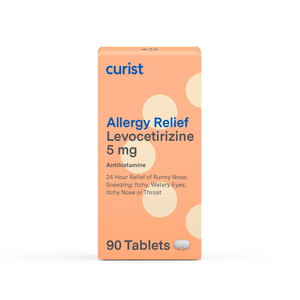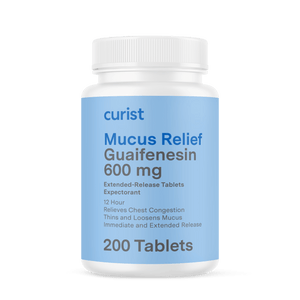by Dr. Marc Goldstein, MD, Curist Allergy Advisor
Curist delivers over-the-counter medicines to your door at a fraction of the price of traditional brands. We hope everyone stays safe and healthy during this time.
Pet Allergies: A Whole Different Animal?
When it comes to allergies, the basic principles are always the same. Your body forms an antibody to a harmless foreign substance. In the case of animals, it is proteins found in your pet’s skin, urine, and saliva -- not their fur -- that can trigger a variety of allergic reactions.
These symptoms may include:
- coughing, wheezing, experiencing shortness of breath
- breaking out into a skin rash or hives
- developing itchy, swollen, teary, or red eyes or eyelids
- experiencing a runny, itchy, or stuffed-up nose
These symptoms can escalate to more serious complications like chronic asthma, chronic sinus headaches and infections, and nasal polyps.
Some of these symptoms overlap with other kinds of allergic reaction. But what differentiates an animal allergy from spring pollen or dust allergies is that your pet’s skin particles, or dander, can be tricky to control. Some of the reasons are obvious and others are more subtle. (For starters, try telling a dog to stay off your bed, and see if she listens.)
It also has to do with the nature of the “beast.” Cats and Dogs shed a lot of skin, and produce a protein, to which many people are allergic.
And you don’t have to be on Noah’s Ark to be susceptible. Did you know that a household that once housed a pet can still hold significant traces of pet allergens, even six months after the pet was removed?
The reason is that the dander particles are very fine, andcan float around in the air creating endless exposure for your eyes, sinuses, nose, lungs and bronchial tubes.
The Truth about Cats, Dogs, and Allergies
Cats vs. Dogs? The eternal debate never mentions that BOTH kinds of furry friend can bring as much dander as joy.
Are you a Dog Person with Dog Allergies?
Dogs can spread allergens throughout your house, particularly the more time they spend indoors, and especially in the rooms where they spend the most time.
In addition, interacting with your dog raises your exposure to potential allergens. Every time you pet your dog, every time a dog licks your hands and face or climbs into your bed, you are receiving more and more allergens.
If you notice symptoms related to these activities or environments, you may have a dog allergy.
Are You a Cat Person with Cat Allergies?
Cats win out...as the more allergenic of the two.
You’re twice as likely to be allergic to cats than dogs. There may be a number of reasons why this is the case. Cats lick themselves as part of their grooming routine, spreading their saliva. Their dander may also be more “sticky” than that of other animals, causing it to stubbornly remain in carpets, bedding, furniture, floors, and walls.
Whatever the reason, if you notice chronic allergy symptoms cropping up whenever a black cat crosses, it might not be superstitious to see an allergist.
Other Animal Allergies?
It’s not just dogs and cats that can cause allergic reactions.
Perhaps you work in a research laboratory with animals? Perhaps you keep birds as pets? Maybe you’re a schoolteacher with a class rabbit, or a parent whose kids love horses? A veterinarian? A dairy farmer with cows? Whatever the case may be -- you could very well have sensitivities to any number or kind of animal species.
It’s smart to monitor yourself for occasional, recurring or chronic symptoms like those listed above, as they may be the result of specific allergens. You can also see an allergist, who can pinpoint whether animal allergies are the cause of your symptoms.
What about Hypoallergenic Dogs and Cats?
Sadly, there’s no such thing. Hypoallergenic refers to something that is unlikely to cause an allergic reaction. While it’s possible that certain people and certain breeds might be a better “allergenic match” for one another, there are no “safe” breeds if you have this particular sensitivity. No, not even poodles. The reason is that even if one dog sheds less fur than another (reducing the amount of dander spread around), all dogs still shed their dead skin cells and spread their saliva around the home.
Some Tricks for Your Pet Allergy
So what can you do to limit your exposure to pet allergies? Here are some tips.
- Avoid Pet Allergen Shelters
- The fewer hiding spots you allow allergens to hide, the easier time you’ll have keeping a suitable environment for yourself.Overstuffed furniture, carpets, drapes, bedding, and the like are reservoirs for dander. The more of these you have, the harder time you’ll have eliminating allergens. Choose leather furniture, blinds, and hard surfaces where possible.
- Wash all your bedding and clothing often. And wash your dog’s bedding, as well, but separately from your own!
- Be mindful of air ducts and filters that trap, store, and spread dander throughout your house or building. Change filters often. If possible, use separate ventilation systems for pet-friendly rooms and for your bedroom.
- Remove Pet Allergens Regularly
- Frequent vacuuming is essential. Make sure your vacuum has a micro-filtration bag or is HEPA filter-equipped.
- A HEPA filter air cleaner is a smart way to remove allergens from the air. Opening windows are another approach, but beware of opening up to pollen and dust allergens, which might trigger a whole new set of symptoms.
- Ask visitors and guests not to wear clothing that has been in contact with their pets, and which might foil your hard work by bringing in more allergens.
- Get Your Pet Wet (and Clean)
- Scientific studies have confirmed that washing your pet weekly significantly reduces its allergen load, perhaps up to 85%. It’s easiest to begin this habit when the pet is young. Whoever washes or grooms the pet should not be the person who is allergic.
- “Sorry, No Pets Allowed”
- Designate only certain rooms for your pets. Keep pets out of your bedroom at all times. And close your door while you sleep. An invisible fence or an enclosed door are essential barriers to keep your bedroom allergen-resistant. It may sound harsh, but it’s your best chance at sleeping and breathing easy.
When Pet Allergies Just Can’t be Tamed?
Unfortunately, despite your best efforts, it might not be possible to eliminate your exposure to pet allergens. In these cases, there are medicines you can turn to alleviate symptoms and might suit you better than parting ways with your lovable pet.
Consult an allergist for more information on further treatment options.












